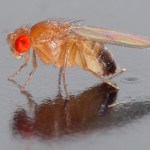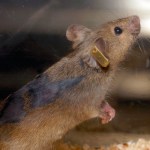fruit fly
Image by Botaurus - Wikimedia commons
A changing climate has the potential to greatly impact ectotherms, which depend on the environment to regulate their own body temperatures. In a new study published in the American Journal of Physiology- Regulatory, Integrative and Comparative Physiology, researchers were curious how exposure to varying temperatures would affect developing ectotherms. They answered this question using Drosophila melanogaster, commonly known as fruit flies. They exposed freshly laid eggs to ten different temperatures ranging from 12 to 32°C, the upper and…
"Drosophila melanogaster - side (aka)" by André Karwath aka Aka - Own work. Licensed under CC BY-SA 2.5 via Wikimedia Commons -
Researchers at the University of California at San Diego were interested in understanding how exposure to low oxygen concentrations impact heart function. For humans low oxygen delivery to the heart can occur with exposure to high altitude, respiratory diseases, inflammation, blood clots and during a heart attack when there is inadequate blood flow to the heart muscle. The results of their study were recently published in the American Journal…
Image of common model organisms from European Molecular Biology Laboratory (EMBL).
A recent article posted in the BBC News provided a good explanation of why scientists commonly study these organisms as models for human diseases and conditions. Model organisms are chosen because their physiology is similar to other animals, including humans, in addition to other reasons:
Visit the BBC News to see why researchers most often use flies, fish, mice and worms to understand the mechanisms of disease and health.
Did you know that ~70% of the genes in a…
THE humble fruit fly (Drosophila melanogaster) has the ability to learn and remember, and to make predictions about the outcome of its behaviours on the basis of past experience. Compared to a human brain, that of the fruit fly is relatively simple, containing approximately 250,000 cells. Even so, little is known about the anatomical basis of memory formation. The neural circuitry underlying memories in these insects has now been dissected. In an elegant new study published in the journal Cell, researchers from the University of Oxford show that aversive memories are dependent on…
This is the second of eight posts on evolutionary research to celebrate Darwin's bicentennial.
What do you get when one species splits into separate lineages? Two species? Think bigger...
When new species arise, they can set off evolutionary chain reactions that cause even more new species to spring forth - fresh buds on the tree of life create conditions that encourage more budding on different branches.
Biologists have long suspected that these "cascades of speciation" exist but have struggled to test them. Enter Andrew Forbes from the University of Notre Dame - his team of has…
A True Fruit Fly - Tephritidae
Fruit flies are a family, Tephritidae, containing about 5,000 species of often strikingly colored insects. As the name implies, these flies are frugivores. Many, such as the mediterranean fruit fly, are agricultural pests.
Drosophila melanogaster, the insect that has been so important in genetic research, is not a true fruit fly. Drosophila is a member of the Drosophilidae, the vinegar or pomace flies. They are mostly fungivores, and their association with fruit is indirect: they eat the fungus that lives in rotting fruit. …

